I drove into the Strasburg Rail Road parking lot at 8:30 AM and learned that the first train I could ride would not leave at 11:00 AM. Since it was very cold and windy, I decided to explore.
Strasburg RailroadThe Strasburg Rail Road (reporting mark SRC) is the oldest continuously-operating railroad in the western hemisphere and the oldest public utility in the Commonwealth of Pennsylvania. Chartered in 1832, the Strasburg Rail Road continues to operate under its original charter and original name (Strasburg Rail Road Company). Located just outside of the town of Strasburg, Pennsylvania, the railroad is a heritage railroad offering excursion trains, hauled by steam locomotives, through the heart of world-famous Pennsylvania Dutch Country. Strasburg currently has five serviceable historic steam locomotives (Canadian National 7312, Canadian National 89, Great Western 90, Norfolk and Western 475, Brooklyn Eastern District Terminal 15 (rebuilt as Thomas the Tank Engine) on its roster and has the nation's largest fleet of historic wooden passenger coaches in operation. The Strasburg Rail Road is also one of the few railroads in the United States to occasionally use steam locomotives to haul revenue freight trains. It hosts 300,000 visitors per year.
Across the street from the Strasburg Rail Road is the Railroad Museum of Pennsylvania. The Strasburg Rail Road serves as the Museum's physical rail connection to the Amtrak Philadelphia to Harrisburg Main Line junction in Paradise, Pennsylvania.
Strasburg Rail Road is a shortline railroad whose construction in the 19th century was intended to connect the town of Strasburg with the main line. Today, the original 4.5 mile line carries passengers on a 45-minute round-trip journey from Strasburg to Leaman Place Junction through nearly 2,000 acres in southeastern Lancaster County.
The train includes the United States' only operational wooden dining car on which visitors may dine while riding. Attractions at the station include the fully operational 15 inch gauge Pint-Sized Pufferbelly (Cagney steam-powered ridable miniature railway) a vintage pump car and several c.1930s "cranky cars" along with several gift shops and a cafe.
In addition to the excursion train rides, Strasburg Rail Road mechanical and car shops conduct contract work for a wide variety of public and private clients including fellow steam railroads, train museums, attractions and more. Strasburg Rail Road's freight department facilitates the carrying of goods to and from the main line for a number of local and regional clients. In 2016, it was announced that they are to expand their shop an extra 12,000 square feet due to the increase of jobs from other railroads.
HistoryBy the 1820's, the canal system had replaced the Conestoga Wagon as the primary method of long-distance transportation. When the Susquehanna Canal opened, the majority of goods were directed through Baltimore, Maryland rather than Philadelphia. The small amount of goods that were destined for Philadelphia traveled via a wagon road through Strasburg. Philadelphia attempted to reclaim its position as a major port city by constructing the Philadelphia and Columbia Railroad in 1831. A railroad was easier and more cost effective to build than a canal. Because the new railroad would bypass Strasburg and cause Strasburg to lose its livelihood, a group of businessmen petitioned the state government for the right to build their own railroad to connect Strasburg to the Philadelphia and Columbia. A charter was issued by the Pennsylvania Legislature with the signature of Governor George Wolf on June 9, 1832 to "incorporate the Strasburg rail road".
Although the pre-1852 history of the Strasburg Rail Road is sketchy, it is believed that the line was graded in 1835 and was operational by 1837. The railroad operated as a horse-drawn railroad until it purchased a second-hand Norris-built, 4-2-0 steam locomotive named the William Penn in 1851. Controlling interest in the railroad was purchased by John F. and Cyrus N. Herr in 1863. The rails were replaced around the same time with heavier ones to accommodate the locomotive. In 1866, the Herrs were granted a charter to extend the Strasburg Rail Road to Quarryville; surveys were carried out, but the extension was eventually canceled because of an economic depression in 1867. Isaac Groff managed The Strasburg Rail Road for about 20 years until the destructive fire of January 16, 1871 which destroyed the depot, grist, and merchant-mill, planing-mill and machine-shop. In one night, over fifty thousand dollars' worth of property was destroyed. In 1878, the Strasburg Rail Road and the shops were sold. The railroad was eventually again sold in 1888 to the Edward Musselman, with the Musselmans retaining control of it until 1918, when it was purchased by State Senator John Homsher. By this time, the number of passengers had dropped off due to tracks for the Conestoga Traction Company's streetcars reaching Strasburg in 1908, which offered a more direct route between Lancaster and Strasburg.
In 1926, the Strasburg Rail Road purchased a 20-short-ton, gasoline-powered, Plymouth switcher-the only locomotive that was ever built specifically for the Strasburg Rail Road. By 1958, the railroad fell on hard times from a cumulative effect of years of declining freight business and infrequent runs, damage caused by Hurricane Hazel, and inspectors from the Interstate Commerce Commission's lack of approval for operation of Plymouth locomotive 4. Upon the death of Bryson Homsher, the Homsher estate filed for abandonment with the Pennsylvania Public Utility Commission. Hearing of the potential abandonment, an effort to purchase and save the railroad was organized by Henry K. Long and Donald E. L. Hallock, both railfans from Lancaster. They organized a small, non-profit group to purchase the railroad. After the better part of a year of hard work, the purchase was completed on November 1, 1958. The following week, on November 8, the first carload of revenue freight was hauled to what was then the only customer, a mill in Strasburg.
My Visit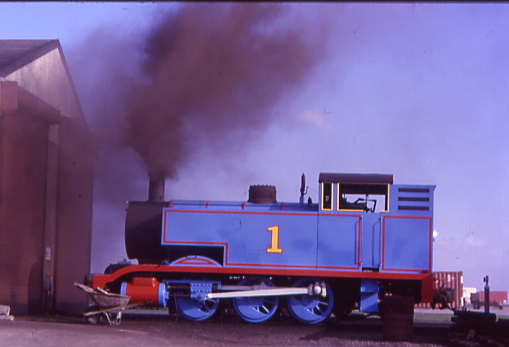
I quickly saw smoke which led me to Thomas the Tank Engine 0-6-0 1.
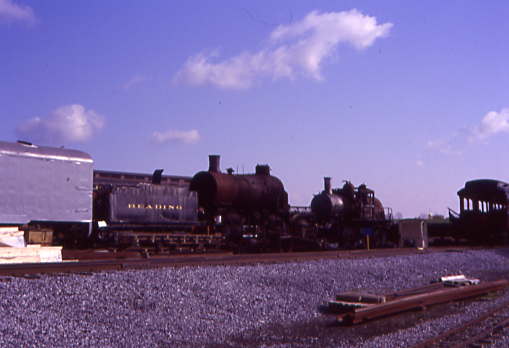
A line of equipment.
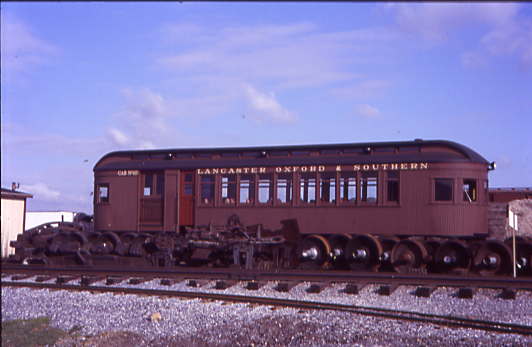
Lancaster, Oxford and Southern Car motor car 10. is the last remaining piece of rolling stock from that long-forgotten little railroad and is believed to be the only piece of its kind built by the Sanders Machine Shop of Havre de Grace, Maryland. Sometime after 1919, the car was sold to the Grasse River Railroad in New York State where it remained until 1960. That year, the motorcar was sold to Winston Gottschalk of the Strasburg Rail Road. After a second full restoration between 1991 and 1997, the car re-entered revenue passenger service and has remained in service ever since.
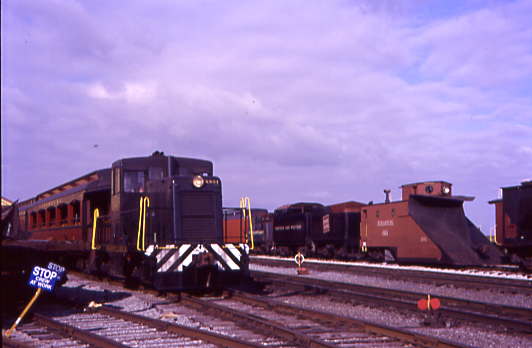
Yard scene.
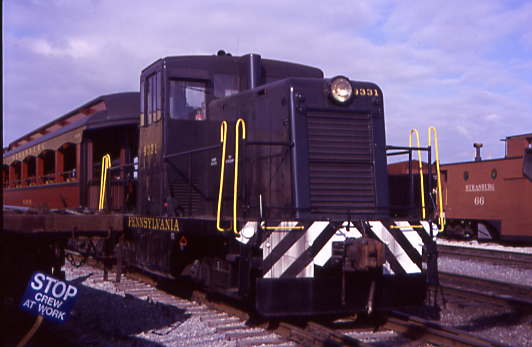
Strasburg Rail Road 45 ton switcher 9331, nee Pennsylvania Railroad 9331 built by General Electric in 1948.
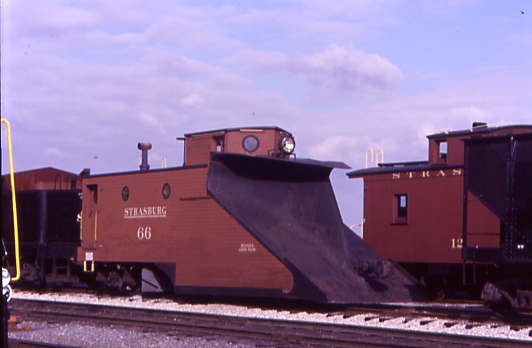
Strasburg Rail Road snowplow 66, ex. Wellsville, Addison and Galeton, nee Buffalo and Susquehanna built by Russell Snow Plow Company circa 1902.
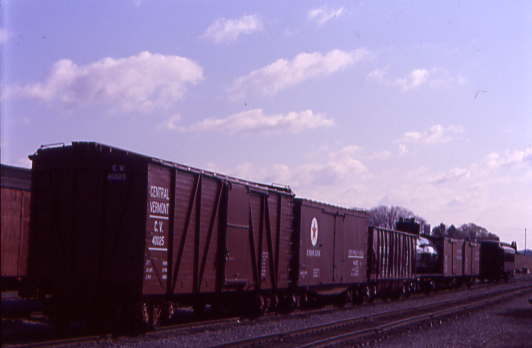
A line of freight cars.
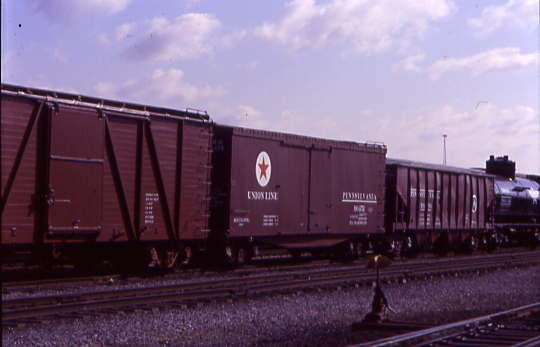
Strasburg Rail Road box car W-04, ex. Strasburg Rail Road 110, exx. New York, Philadelphia and Norfolk Railroad 998, nee Pennsylvania Railroad 96451 built by Pressed Steel Car Company in 1907.
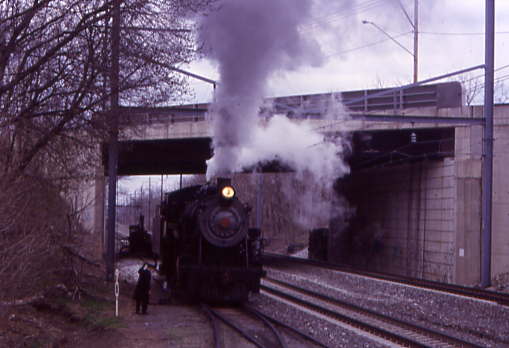
My first view of Great Western 2-10-0 90, built by Baldwin in 1924. After spending 40 years of hauling commodities—primarily sugar beets—through the mountains of northern Colorado, she was sold to the Strasburg Rail Road in 1967 for a grand total of just $23,000.
90 was steamed up and ready to start the day pulling the Strasburg Rail Road passenger train. As I did not want to wait in the cold weather for two hours, I decided to visit the Railroad Museum of Pennsylvania across the street.
At 10:35 AM, I finished at the museum and recrossed the highway to the Strasburg Rail Road, bought my ticket and went to the offices to look for Katie Stafford, who would be my host. My ticket was refunded and I was given a train ticket, as well as a 12:00 PM shop tour ticket. The office staff Katie on her cell phone and I walked outside to wait then a few minutes later, Katie and her friend, Kimberley Carlo, arrived and we walked over to the waiting train.
The Ride on the Strasburg Rail Road 4/9/2007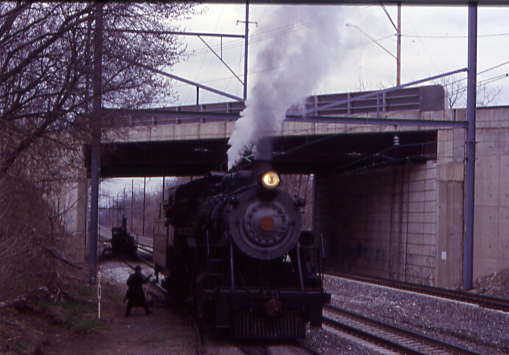
Great Western 90 would pull the train backwards to Paradise. Our train consisted of Great Western 2-10-0 90, coaches 62 "Gobbler's Knob" built in 1897, 72 "Mill Creek" built in 1906, 59 "Grasshopper Level" built in 1904, 65 "Walnut Hollow" built in 1910, 105 "Warren F. Benner", diner 93 "Lee E. Brenner" built in 1909, table/parlour 75 "Henry K. Long" and parlour 88 "Marion". The three of us boarded "Gobbler's Knob" and chose seats in the middle.
My hosts for the trip were Katie Stafford, media contact for the Strasburg Rail Road and her friend Kimberly Carlo. We left on time at 11:00 AM, passing the shops and a rather large farm then the train whistle blew for our crossing of Paradise Lane.
We next passed the Red Caboose Motel, where I would be spending the night.
A Amish farm to the south. The three of us enjoyed getting to know each other as I took pictures every so often. I told about my stay at Intercourse and they thought Theory 3 made the most sense. We passed the Esbenshade Turkey Farm and Katie told me that ticket sales not only pay the bills, but assist in helping local farmers. Since we already have "Farm Aid", I guess this could be called "Train Aid".
Another Amish farm through the smoke. The train stopped and they said if you listen closely, you could hear the whistle of the ghost train. 90 blew its whistle several times before we continued.
This area of Pennsylvania is well-known for the Amish way of life. The train passed through the Groffs picnic area.
Crossing the rural landscape before we entered Paradise, next to Amtrak's Harrisburg-to-Philadelphia corridor.
Great Western 90 then cut off our train.
Great Western 90 ran around the train to be on the point for our return trip.
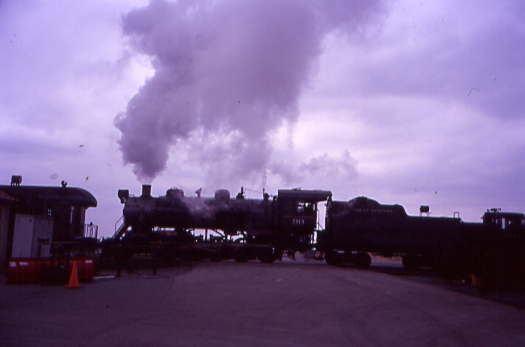
Here came the steam engine running around our train. We had an enjoyable journey back to Strasburg and spotted Thomas the Tank Engine following us. Once back, Katie gave me a tour of the rest of the train.
Interior of Strasburg Rail Road coach 59 "Grasshopper Level", nee Boston and Maine 1182 built by the railroad in 1904 B&M Salem Shops 1904. The Rail Road acquired it in 1959 and it was restored in 1998.
Interior of Strasburg Rail Road dining car 93 "Lee E. Brenner", nee Boston and Maine 1271 built by Laconia Car Company in 1909. It is named in honor of the Strasburg Rail Road Company's second president who served briefly from 1963 to 1964.
Interior of Strasburg Rail Road parlour car 75 "Henry K. Long", nee Boston and maine 1293 built by Laconia Car Company in 1910. After it was retired from service, it was sold to the Strasburg Rail Road where two years later, the car entered service. Its name of "Henry K. Long" is in honor of the first president of the revived Strasburg Rail Road Company, Henry Keiper Long. Long was president of his family's business, Lancaster Champion Blower & Forge, and spearheaded the effort to save and revive the Strasburg Rail Road in 1957–1958.
Interio of Strasburg Rail Road parlour-observation car 88 "Marian", ex. Strasburg Rail Road "Pequea Creek" 1971, nee Boston and Maine 1393 built by Laconia Car Company in 1910. The Strasburg Rail Road purchased the car in January 1971 and in 1988, transformed the car into the top-of-the-line luxury railcar. Its name of "Marian" is in honor of the Strasburg Rail Road Company’s first corporate secretary and the wife of William M. Moedinger, the third president of the tourist company. Marian Moedinger was one of the original 24 shareholders who helped revive the railroad in 1958 and save it from abandonment.
The bar in the "Marion".
Next we went to the 12:00 PM shop tour and on the way there, passed a live steamer that pulls the children around on a miniature railway.
Strasburg Rail Road Shop Tour 4/9/2007We all met inside the shop office and signed our releases then started our shop tour.
Inside we found another Thomas the Tank engine, which is one of the four dummy versions, meaning they do not steam and cannot move by themselves. There are currently five Thomas the Tank engines in North America and only one can steam live down the tracks.
Inside the machine shop, Tim Heller was our tour guide, showed us one of Strasburg Rail Road's 20 ton gasoline engine 1 built by Plymouth in 1926.
View inside the machine shop.
Strasburg 4-8-0 475, nee Norfolk and Western 475 built by Baldwin in 1906, was undergoing restoration.
The crank pin for Union Pacific 4-6-6-4 3985.
Tim Heller, our tour guide, at the wheel lathe.
Rio Grande Southern 20 is also undergoing restoration here.
The cab end of Strasburg 475.
Wheels and tires for Union Pacific 4-6-6-4 3985. Next on the tour was the car shop.
After the car shop, we walked over to the restoration shop where we found 99 "Valley View", ex. Boston and Maine W3145, nee Boston and Maine 1313 built by Laconia in 1910 and acquired in 1972.
There was another Thomas the Tank Engine here. We walked outside and passed the locomotives.
Once outside, we walked by the engines, including Strasburg 2-6-0 89, ex. Canadian National 911, nee Grand Trunk Railway 1009 built by Canadian Locomotive Company in 1910 and acquird in 1972. It was submerged at Wilkes Barre during Hurricane Agnes flood in June of that year and was first run on March 17, 1973.
Inside the engine house, we found another small diesel engine.
One of the railroad's two flat cars.
Members of our tour group in the Engine House.
New flues on the floor, which ended our fantastic tour of the Strasburg Rail Road shops. I said goodbye to Katie and Kimberly before I continued to look around.
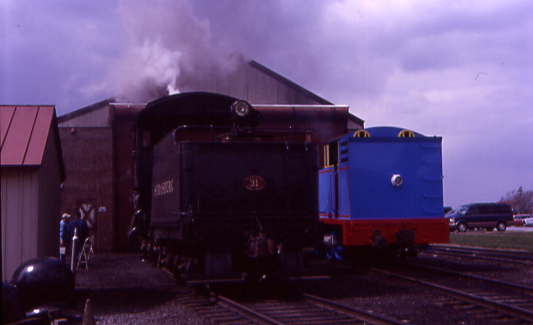
Strasburg Rail Road 0-6-0 31 meeting Thomas the Tank Engine.
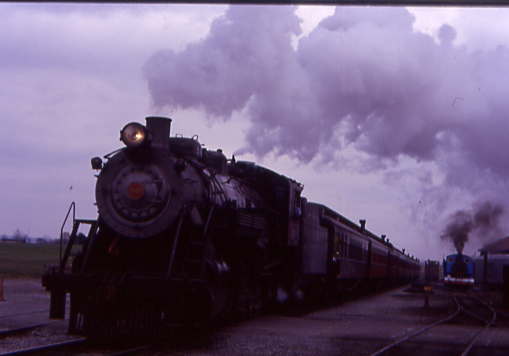
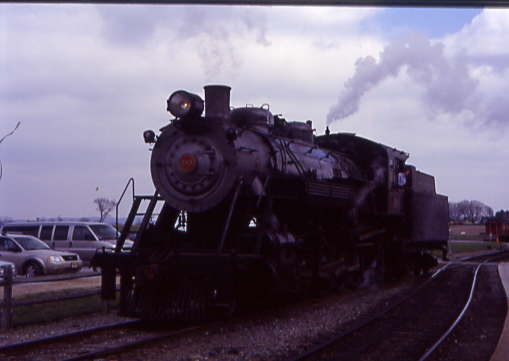
Great Western 90 returning to Strasburg, after which it ran around its train to lead one more trip on this cold and windy day
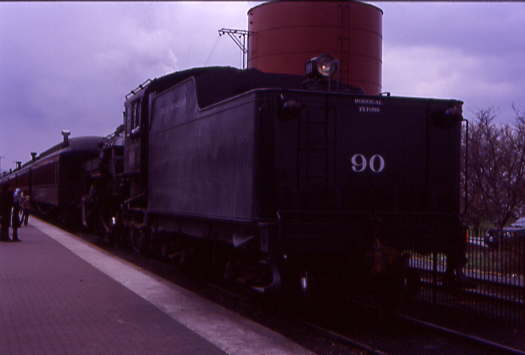
Coupling up to its train, ready for the next trip, which I would chase.
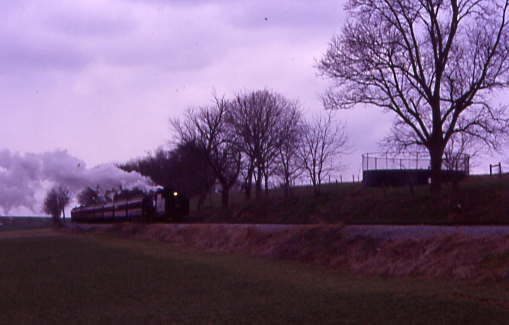
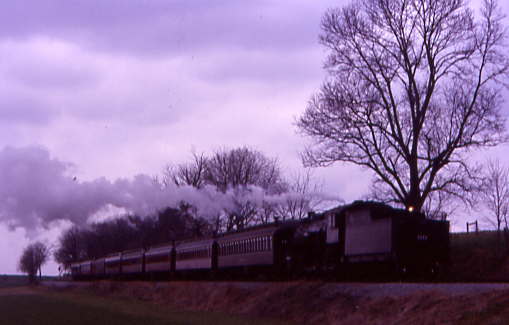
My first runby with Great Western 90.
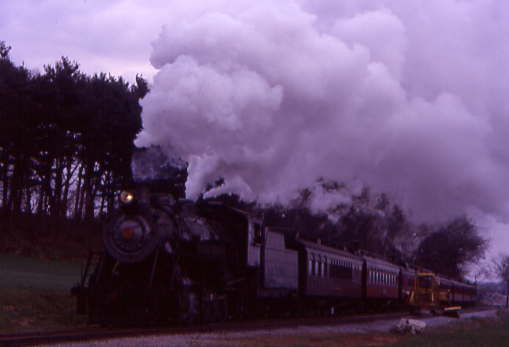
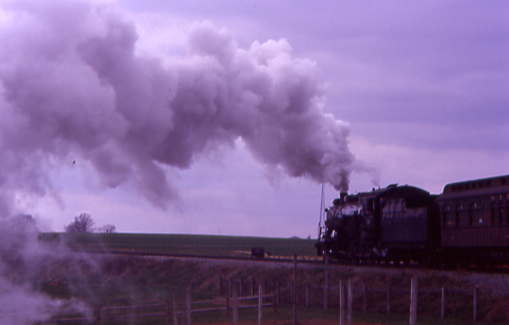
A westbound train at Groff's Picnic Area.
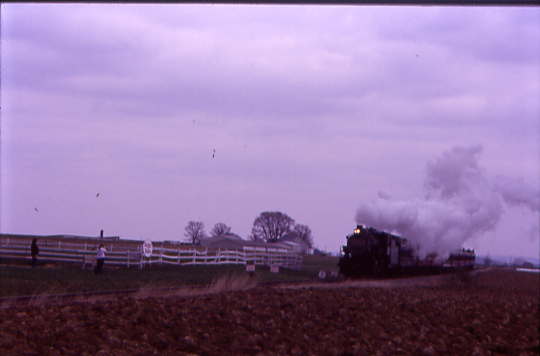
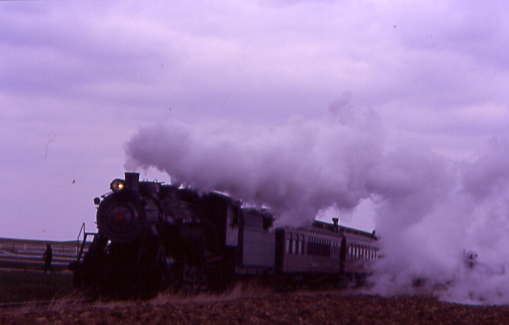
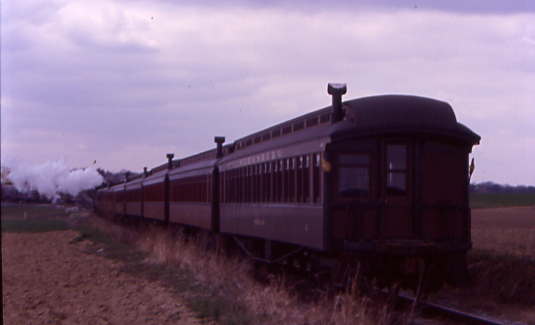
I drove out to Black House Road to wait for the 1:00 PM train to Paradise with Great Western 90 pulling the train backwards. Next I drove to Paradise, where the steam engine switches ends and waited a few minutes.
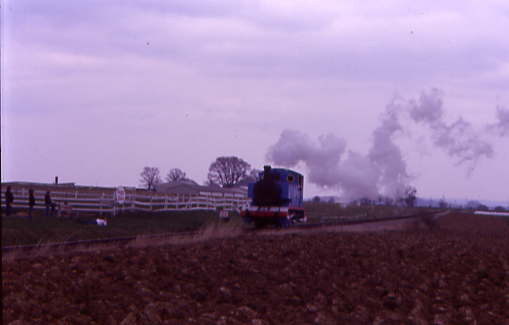
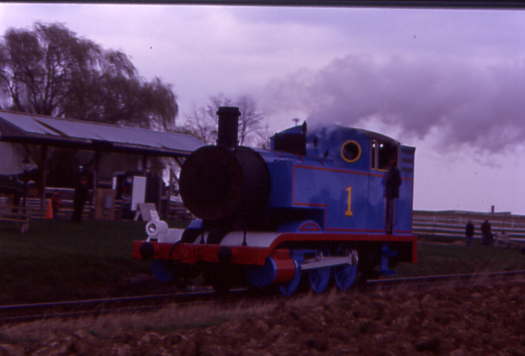
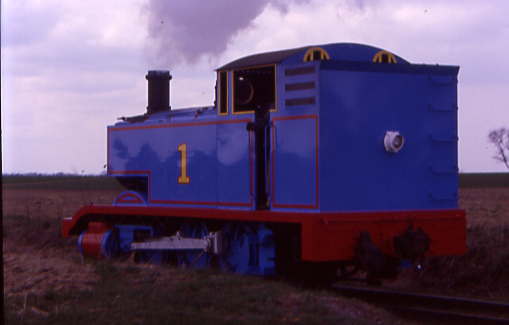
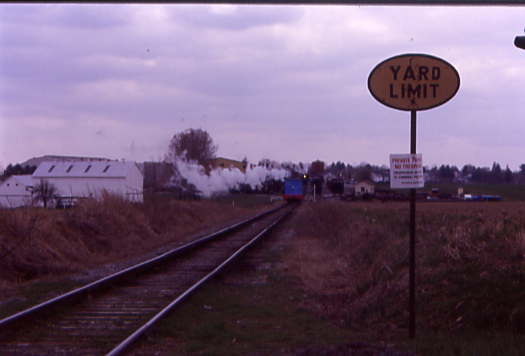
Thomas the Tank Engine returning from Paradise. I returned to Strasburg, stopping at the grade crossing at Cherry Hill Road and after picking up some passengers at Groffs, the train came foward, charging by my location.
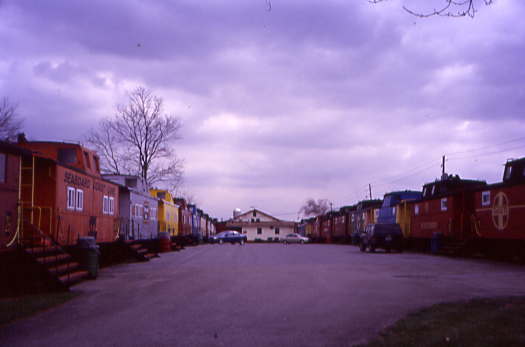
Finally I drove to Paradise Lane, by the Red Caboose Motel and set up for a picture while the Amish were playing a large volleyball game at their farm behind me. I checked into the Red Caboose Motel and drove back to the museum to buy a T-shirt.
View from the Switch Tower J that overlooks the Strasburg station.
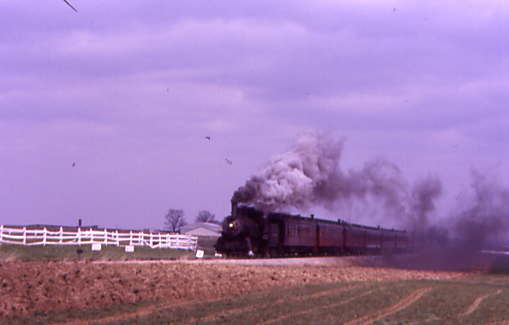
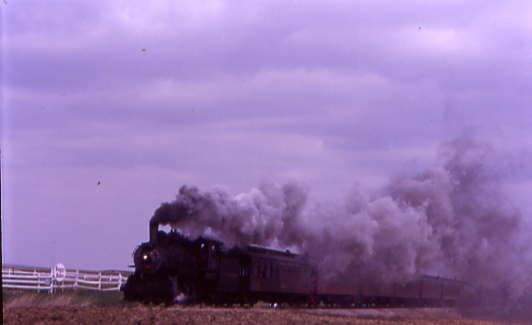
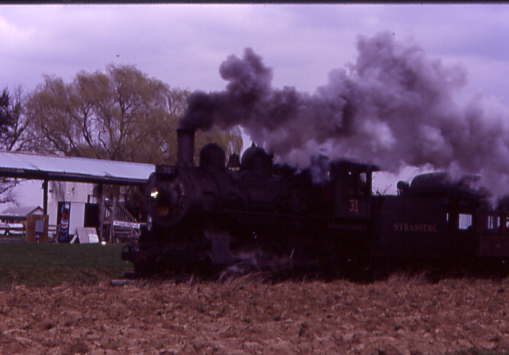
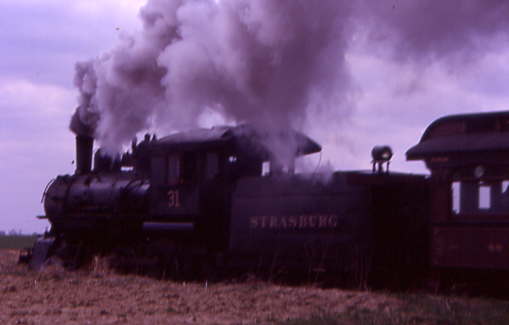
I noticed a different locomotive coming towards me; it was Strasburg 0-6-0 31 which was pulling the late afternoon passenger trains.
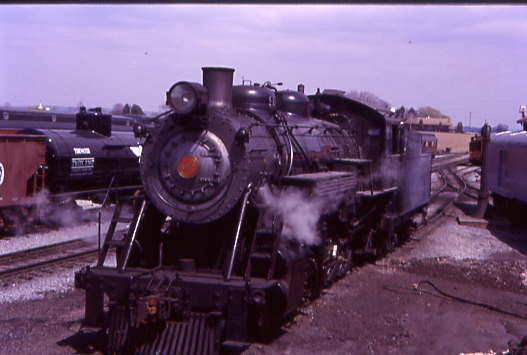
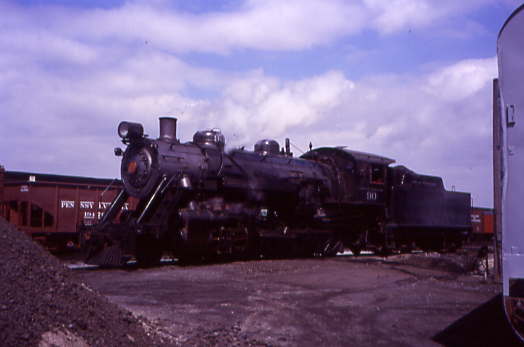
Strasburg 90 pulled into the engine shop.
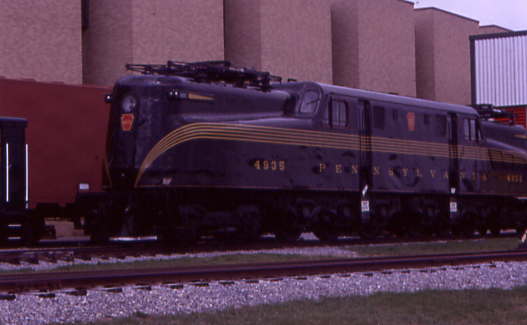
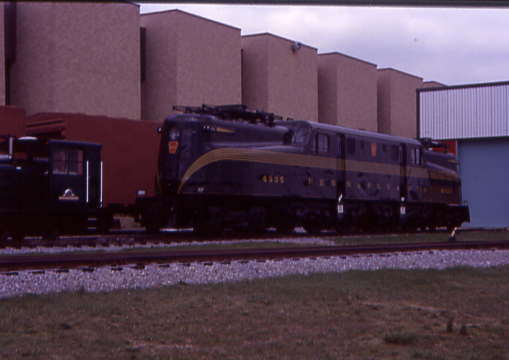
Across the road is the Railroad Museum of Pennsylvania and behind the building, I found Pennsylvania Railroad GG-1 4935 then returned to Paradise Lane grade crossing.
Steam engines at the museum. I drove back to the Paradise Lane grade crossing to wait for the train to return.
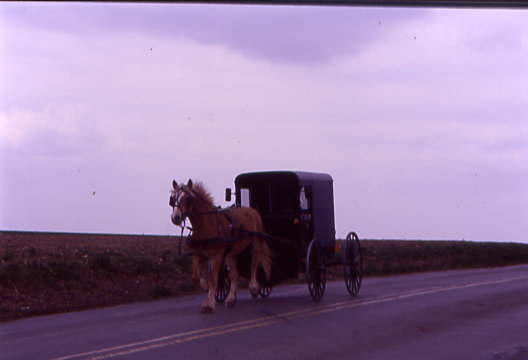
Next, an Amish horse and buggy came down Paradise Lane. I returned to the Strasburg Rail Road.
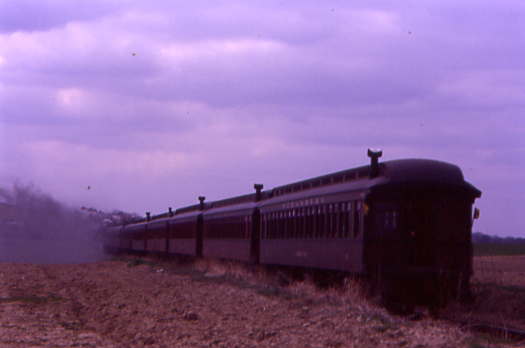
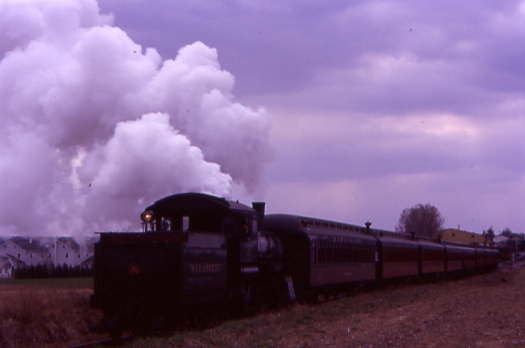
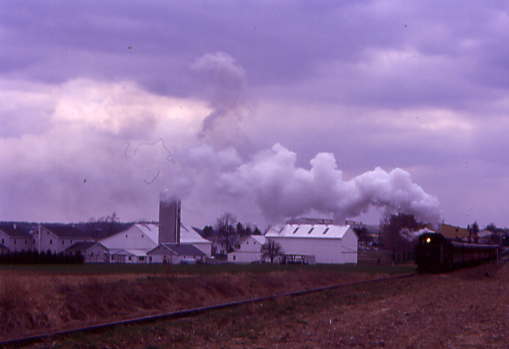
Great Western 90 left the station and I caught him eastbound at Paradise Lane.
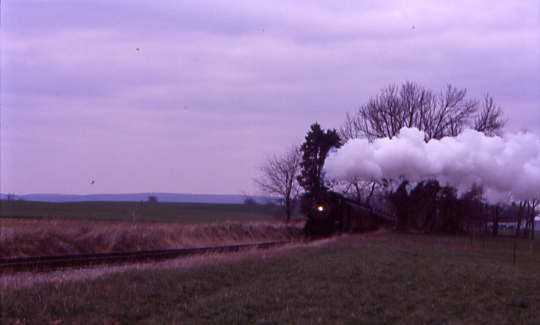
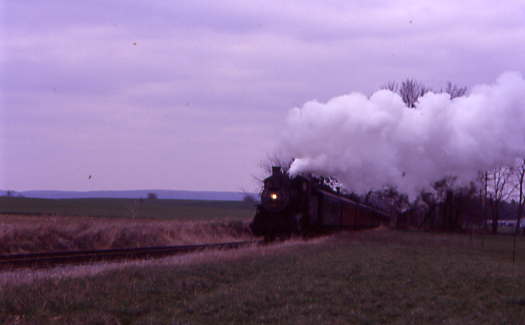
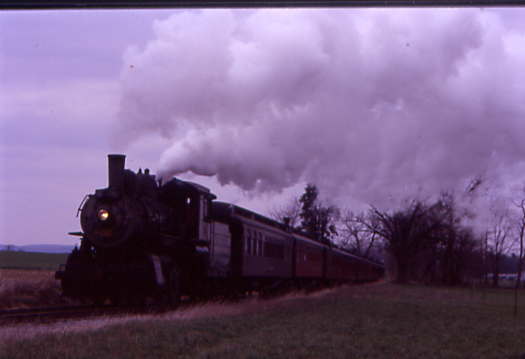
The train at the Paradise Lane grade crossing.
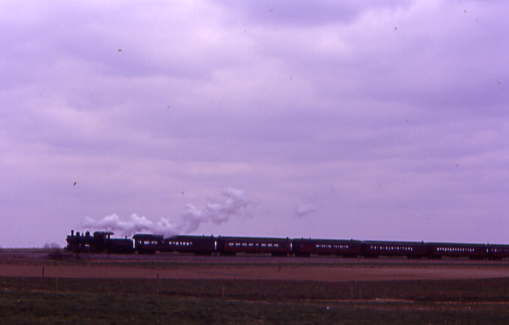
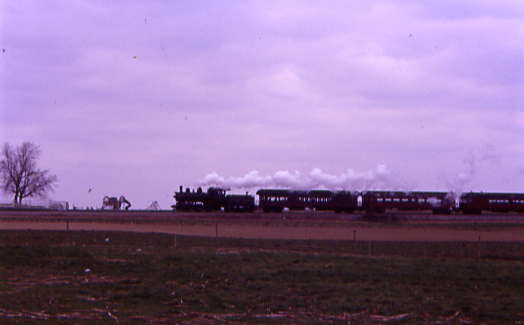
Here came Strasburg Rail Road 31 steaming along Gap Road.
I returned to the Red Caboose Motel for a night of rest after a full day at the Railroad Museum of Pennsylvania and the Strasburg Rail Road.
| RETURN TO THE MAIN PAGE |